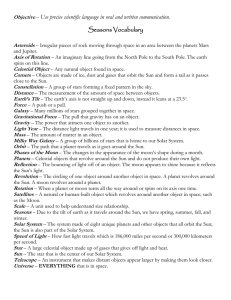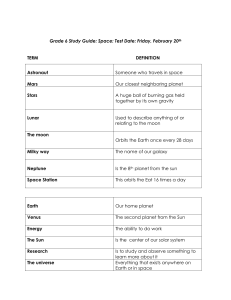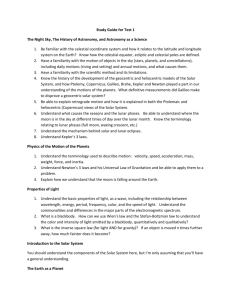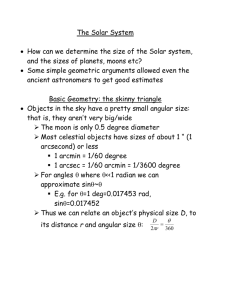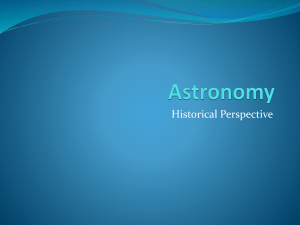Sixth Grade Science Vocabulary by Standard Standards 1 and 2
advertisement
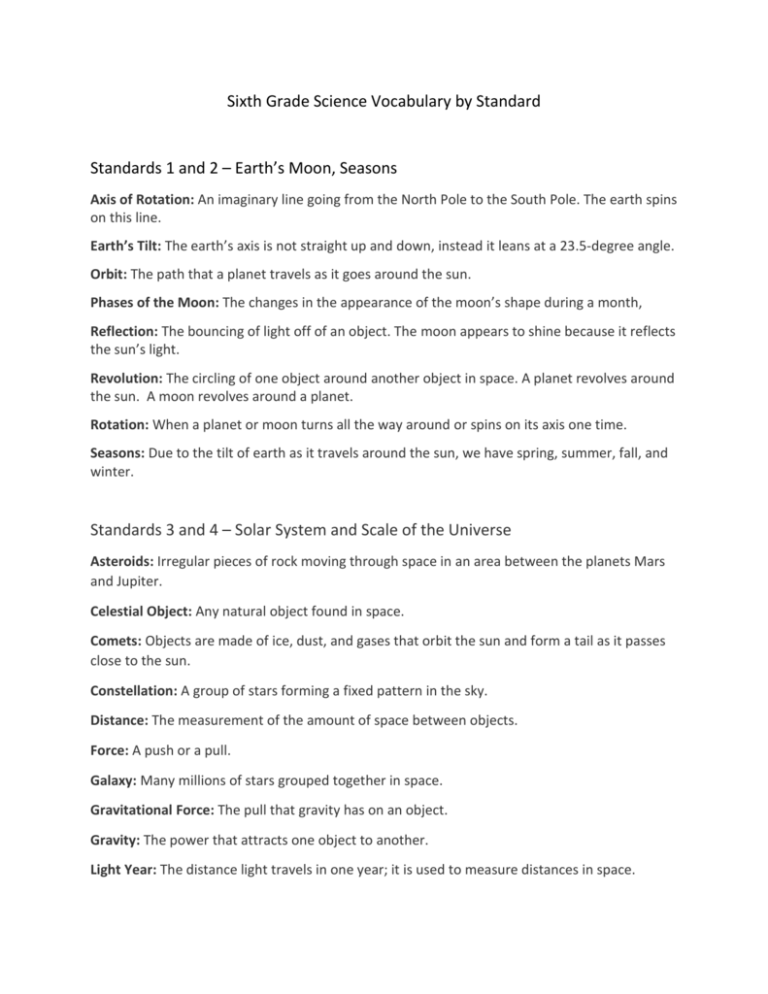
Sixth Grade Science Vocabulary by Standard Standards 1 and 2 – Earth’s Moon, Seasons Axis of Rotation: An imaginary line going from the North Pole to the South Pole. The earth spins on this line. Earth’s Tilt: The earth’s axis is not straight up and down, instead it leans at a 23.5-degree angle. Orbit: The path that a planet travels as it goes around the sun. Phases of the Moon: The changes in the appearance of the moon’s shape during a month, Reflection: The bouncing of light off of an object. The moon appears to shine because it reflects the sun’s light. Revolution: The circling of one object around another object in space. A planet revolves around the sun. A moon revolves around a planet. Rotation: When a planet or moon turns all the way around or spins on its axis one time. Seasons: Due to the tilt of earth as it travels around the sun, we have spring, summer, fall, and winter. Standards 3 and 4 – Solar System and Scale of the Universe Asteroids: Irregular pieces of rock moving through space in an area between the planets Mars and Jupiter. Celestial Object: Any natural object found in space. Comets: Objects are made of ice, dust, and gases that orbit the sun and form a tail as it passes close to the sun. Constellation: A group of stars forming a fixed pattern in the sky. Distance: The measurement of the amount of space between objects. Force: A push or a pull. Galaxy: Many millions of stars grouped together in space. Gravitational Force: The pull that gravity has on an object. Gravity: The power that attracts one object to another. Light Year: The distance light travels in one year; it is used to measure distances in space. Mass: The amount of matter in an object. Milky Way Galaxy: A group of billions of stars that is home to our solar system. Planets: Celestial objects that revolve around the sun and do not produce their own light. Satellites: A natural or human-built object which revolves around another object in space; such as the moon. Scale: A unit used to help understand size relationship. Solar System: The system made of 8 unique planets and other objects that all orbit the sun; the sun is also part of the solar system. Speed of Light: How fast light travels which is 186,000 miles per second or 300,000 kilometers per second. Star: A large celestial object made up of gases that gives off light and heat. Sun: The star that is the center of our solar system. Telescope: An instrument that makes distant objects appear larger by making them look closer. Universe: EVERYTHING that is in space. Standard 5: Microorganisms Algae (AL jee): Plant-like protists that live in water and contain chlorophyll. They produce oxygen and their own food. Bacteria (bac TEER ee a): Microscopic single-celled organisms that exist everywhere. Conclusion: The summary of an experiment, based on data. Control: A part of the experiment that is unchanged. Culture: To grow microorganisms in a specially prepared nutrient medium i.e. growing mold on bread, your bread is your nutrient medium. Decomposer: An organism, often a bacterium or fungus, that feeds on and breaks down dead plant or animal matter. Experiment: A series of steps to find the answer to a question. Fungi (FUN ji): Organisms that are neither plant nor animals, but have characteristics of both and absorb food from whatever they are growing on. Hypothesis (hy PAW thuh suhs): An idea or question that can be tested. Investigation: A process designed to answer a question. Microorganism: A living thing that can only be seen with the aid of magnification. Organism: Any living thing. Protozoan (PRO to zo uhn): A single- celled-animal-like organism that often lives in ponds. Producer: A living thing, like a green plant, that makes its food from simple substances and sunlight. Single-celled organism: Any organism that has only one cell, the smallest unit of life. Variable: A part of an experiment that is changed. Standard 6: Heat, Light, Sound Absorption: Taking in or swallowing up energy. Angle of incidence: The angle at which light strikes a surface. Angle of reflection: The angle at which light bounces off a surface. Conduction: Heat moving between two objects because they are touching. Conductor: A substance that is able to transfer heat energy easily. Convection: Heat transfer in liquids and gases as molecules circulate in currents. Medium: Any substance through which a wave is transmitted. Pitch: How high or low a musical note sounds. Prism: A clear glass or plastic triangular shape that breaks light into the color spectrum. Radiation: The transfer of energy by electromagnetic waves. Reflection: When rays of light or heat are reflected, or bounce off other objects. Refraction: When light bends as it travels from one medium to another. Spectrum: The colors red, orange, yellow, green, blue, indigo, and violet, arranged in order of their wavelengths and seen when white light passes through a prism. (Roy G. Biv) Vibration: A rapid back and forth movement.
